This post may contain affiliate links. If you use these links to buy something we may earn a commission. Thanks.
Tons of shade-loving ground covers are hardy to zone 5 climates! If you’re in need of truly shade-loving plants you’re in the right place.
Most shade-loving plants grow well in partial shade. The majority of this list can thrive in full or deep shade and some need at least partial shade.
Zone 5 offers a pretty long list of options as you’re able to grow everything from zones 3 and 4 lists— that’s 50 more options.
With more than 70 options, you’ll find a variety of plants that not only look good but thrive in your space.
See:
Ground covers that require full sun (6-8 or more hours of direct sun) are not included in any of these shade lovers lists.

For every hardy ground cover you’ll learn about:
- what they look like,
- where they grow natively,
- their hardiness range,
- the main functions they offer you and the landscape,
- ideal lighting requirements,
- soil preferences,
- and where you can source seeds, cuttings, or plants in containers.
From this information, you’ll quickly glance at each plant, stop at the most appropriate ones for your site, and compile a list of the ones you love the most.
The final step to narrowing your list is to check your local invasive species guide and consider alternative options where necessary.
Once you’ve narrowed the list to suit you and your landscape the best, decide if you’ll grow from seeds, cuttings, or transplants.
If you have trouble finding the ideal plants you want—seeds for plants are often available from small businesses on Etsy with free shipping. Otherwise, shop at your local nursery, or order plants in containers from Nature Hills Nursery.
Please share your plant list by commenting on this post and why you made your choices! I’d love to hear about you and your situation.
Rose Of Sharon (Hypericum calycinum)
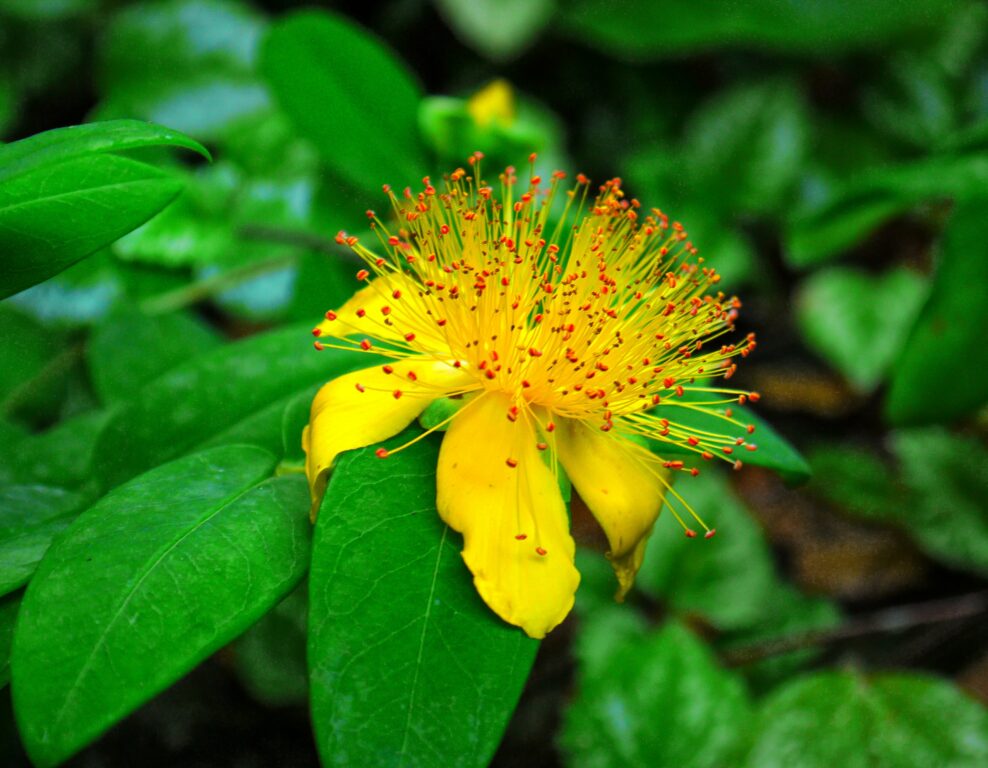
Often mislabelled (or alternatively labeled) as St. Johns Wort (Hypericum perforatum), Rose of Sharon (Hypericum calycinum) is shorter, with larger flowers, and better suited when looking specifically for ground covers!
Both plants will technically “cover the ground” by taking space, but if you’re looking for a showy and low-growing ornamental you’ll love the rose of Sharon. Rose of Sharon is also a shade lover and even thrives in a full shade position, unlike St John’s wort.
- Height: 12-18 inches
- Range: Asia
- Climate: Zones 5-10
- Functions: Used as an ornamental semi-evergreen ground cover. Prevents erosion, is gorgeous when cascading, and attracts butterflies.
- Light requirements: Deep, full, semi, or no shade.
- Soil preferences: Moist or dry soil and drought tolerant. Suitable for heavy clay.
Consider an alternative if invasive in your area, please check before committing.
Nature Hill’s Nursery offers two types of Rose of Sharon (and calls them St. Johns Wort). If you prefer to grow from seed, plenty of options with free shipping are available here.
Related: 13 Erosion Control Ground Covers for Shady Slopes
Box Huckleberry (Gaylussacia brachycera)

Fruit-producing ‘box’ huckleberries grow well in full shade and semi-shade! The best part is once they’re established, their edible (but tasteless) fruit is still produced even with minimal sun.
- Height: 6-18 inches.
- Range: Native to Eastern North America
- Climate: Zones 5-9
- Functions: A popular edible ground cover in food forests. Dense carpeting ground cover for any amount of light.
- Light requirements: Full, semi, or no shade
- Soil preferences: Moist, drained, rich, and neutral-acidic soils.
Few small nurseries sell this specific variety.
Primrose (Primula vulgaris)

Primrose thrives in partial shade and comes in all sorts of colors and flower types. While not native to North America, I’ve never noticed it on an invasive species list. So if you’re looking for a low-growth pop of color the flowers will be out very early—from December to May depending on the climate you’re in.
- Height: 4-12 inches
- Range: Europe, Africa, Asia
- Climate: Zones 5-10
- Functions: Gorgeous low-growing, scented, and edible ornamental flowers
- Light requirements: Partial shade.
- Soil preferences: Moist soil. Suitable for heavy clay.
Various flower colors are available to order here.
Garlic Cress (Peltaria alliacea)
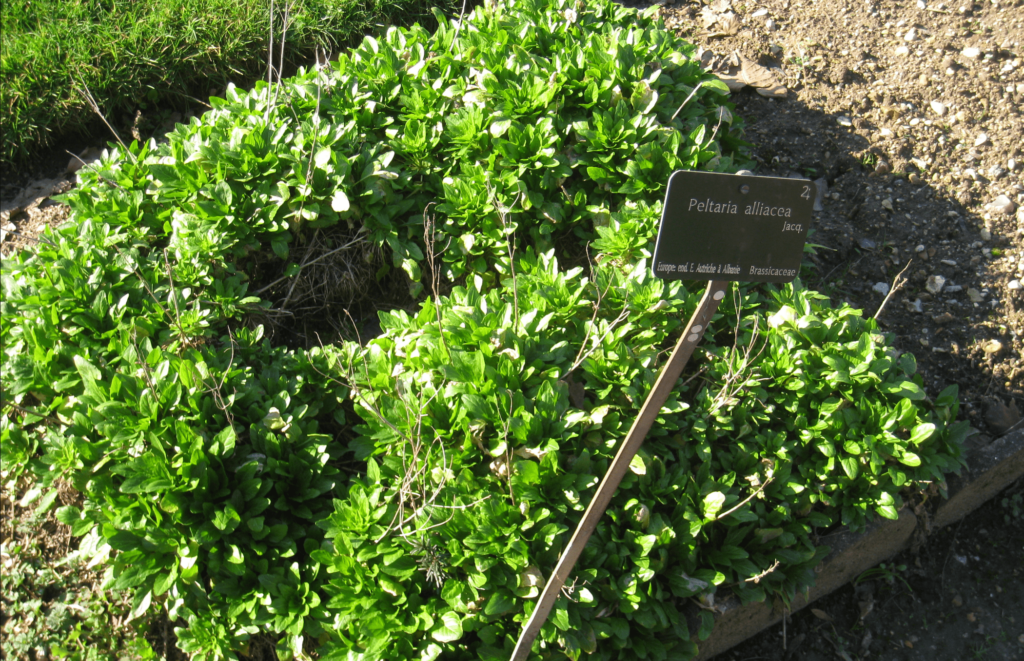
Garlic cress thrives in partial shade, but will grow slowly and overtake weeds with time.
- Height: 24 inches
- Range: Native to Europe
- Climate: Zones 5-9
- Functions: Frangrant scent-confuser, edible, and easy-growing ground cover for food forests, or other gardens that are in need of diversity and pest protection. Often used to enhance the flavor of salads that call for garlic, mustard, or both.
- Light requirements: Partial shade or no shade
- Soil preferences: Moist soil.
Slow growers are best grown from seed as you’ll get more coverage in shorter time. Seeds for garlic cress are hard to come by in some areas—they’re either out of stock or not available near you.
Creeping Snowberry (Gaultheria hispidula)

Creeping snowberry is often chosen specifically as a fast-growing ground cover for shaded areas. Many plants grow in shade, but this one does it fast!
- Height: 8-18 inches
- Range: Native to Eastern North America
- Climate: Zones 5-9
- Functions: An edible and medicinal fruit-bearing ground cover that provides coverage quickly.
- Light requirements: Partial shade.
- Soil preferences: Moist or wet soil.
Creeping snowberry seeds are available here.
See: 19 Tasty Fruiting (Low-Growing) Ground Covers
Beetleweed (Galax urceolata)

Beetleweed looks a lot nicer in person or when a photo is taken at the right angle. The flowers make grogeous additions to bouquets and you can pick them from June to July.
- Height: 10-20 inches
- Range: Native to North America
- Climate: Zones 5-8
- Functions: Polyculture for native, woodland, or food forest gardens. Suitable ground cover for dry shade.
- Light requirements: Full or partial shade.
- Soil preferences: Dry or moist soil.
At the current time, this one is tough to find for sale. I recommend searching in local Facebook groups.
Loce Restorer (Sedum anacampseros)

This is one of few sedums that can thrive in partial shade, but I would advise against a full shade position.
- Height: 3-6 inches, and up to 8-10 inches when flowering
- Range: Native to Europe
- Climate: Zones 5-9
- Functions: Edible and ornamental succulent leaves but primarily grown for ground coverage purposes.
- Light requirements: Partial or no shade.
- Soil preferences: Dry or moist soil and drought tolerant once established. Suitable for heavy clay.
If you’re set on a succulent ground cover for shade, be sure to select a variety that is known for tolerating shade. Succulents in general prefer full sun, but some varieties, like Loce Restorer, love partial shade too.
Nature Hill’s Nursery offers about 7 variety of sedums (from green to pink) that grow in partial shade. Go here and ‘check’ the ‘partial shade’ box to be sure you’re looking at the right options!
Greater Celandine (Chelidonium majus)

This unique (and historically medicinal) ground cover is soft to the touch yet textural to the eyes. If you need your ground covered in no time, greater calendine will green up your space quickly.
- Height: 14-22 inches
- Range: Native to North America, Europe, and Asia
- Climate: Zones 5-8
- Functions: Fast-growing ground cover for shade with attractive yellow flowers. Commonly used in pollinator, food forest, or woodland gardens.
- Light requirements: Full, partial, or no shade.
- Soil preferences: Moist and adaptable to various soil types. Suitable for heavy clay.
Seeds available here.
Related: 16 Fast-Growing Ground Covers to Make Shade Lush
Pine-Mat Manzanita (Arctostaphylos nevadensis)

Pine-Mat Manzanita is an evergreen suitable for growing near seashores and partial shade. It’s less often grown compared to bearberry (Arctostaphylos uva-ursi)—a closely related species.
Bearberry is hardy to zone 4 and thrives in full shade, but not near seashores.
So you could grow pine-mat manzanita if you’re near the sea and have partial-shade to fill, or bearberry if you have full shade and are not near the sea.
- Height: 10-18 inches
- Range: Native to North America
- Climate: Zones 5-9
- Functions: Pollinator plants for bees, and evergeen ground coverage. Edible fruit and medicinal qualities. Often used in native, woodland, or food forest gardens.
- Light requirements: Partial shade.
- Soil preferences: Moist, acidic, and well drained soil.
Seeds available here.
Corsican Mint (Mentha requienii)
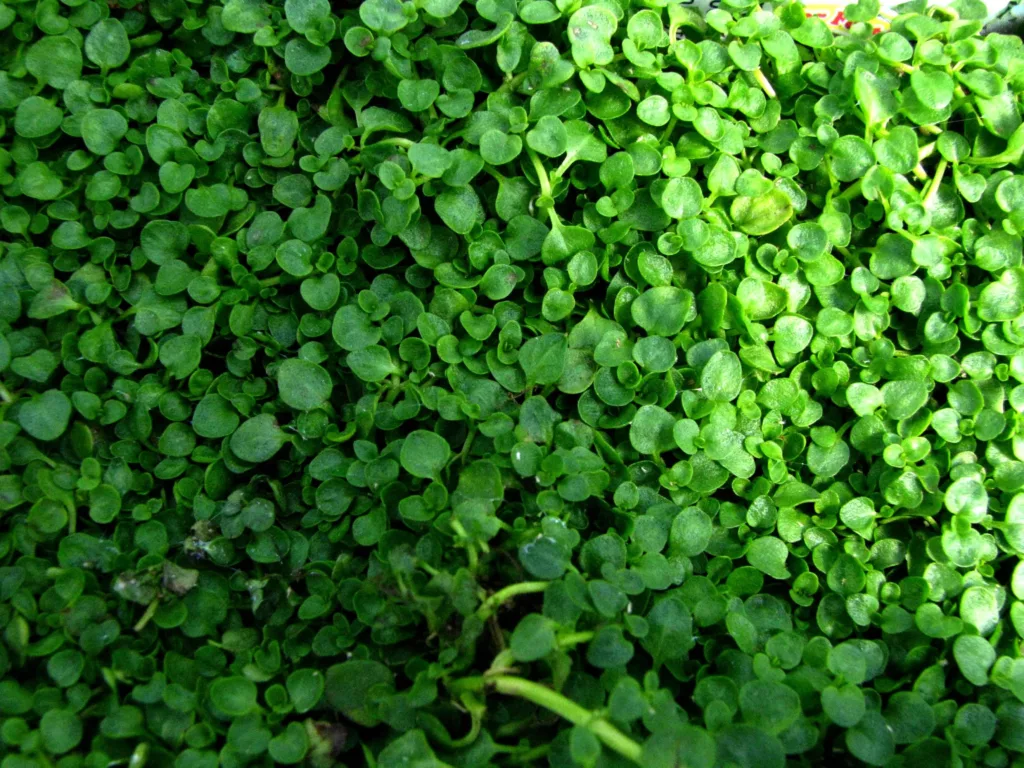
An increasingly popular ground cover for its frangrance and cuteness. It smells very much like peppermint and is edible in the same ways.
Unlike a lot of mints, this type prefers partial shade over full sun as it grows very low to the ground and dislikes when soil gets too dry.
- Height: 1-2 inches
- Range: Native to Europe
- Climate: Zones 5-9
- Functions: Scent-confuser to prevent pest issues and attract a variety of wildlife and overall balance. Flowers attract beneficial pollinators—bees and butterflies from July to August.
- Light requirements: Partial shade.
- Soil preferences: Moist soil. suitable for heavy clay.
Seeds are available here.
Related: Best Walkable Ground Covers for Shade (In Order)
Wall Germander (Teucrium chamaedrys)

If you’re looking for a lush but low-growing plant that acts like a hedge, this is a great option. It’s semi-evergreen and densely covers the ground with fine foliage and deep pink flower spikes.
- Height: 10-12 inches
- Range: Native to Europe
- Climate: Zones 5-9
- Functions: Often used as an ornamental, fragrant, and low growing hedge or border in or around rocks. Bees pollinate the flowers from July to September. They also attract beneficial wildlife and serve as a ‘scent-confuser’ that may help prevent pest imbalances.
- Light requirements: Partial shade is ideal.
- Soil preferences: Moist or dry soil. A wide range from light to heavy soils. Suitable for heavy clay.
Plants or seeds are available here or here.
Related: 15 Easiest Ground Covers that Thrive in Shade
Green Hellebore (Helleborus viridis)

With moist alkaline soil and partial shade, you have the perfect recipe to host the gorgeous green hellebore. This ground covers flowers early from February to April depending on some areas.
- Height: 12 inches
- Range: Native to Europe
- Climate: Zones 5-9
- Functions: Ornamental ground cover and a slug trap crop.
- Light requirements: Partial shade.
- Soil preferences: Moist alkaline soil with drainage. Suitable for heavy clay.
Hellebores may not be the most effortless of all ground covers, in the beginning, but they sure are gorgeous once established. Several flower colors are available here.
Japanese sedge (Carex hachijoensis)
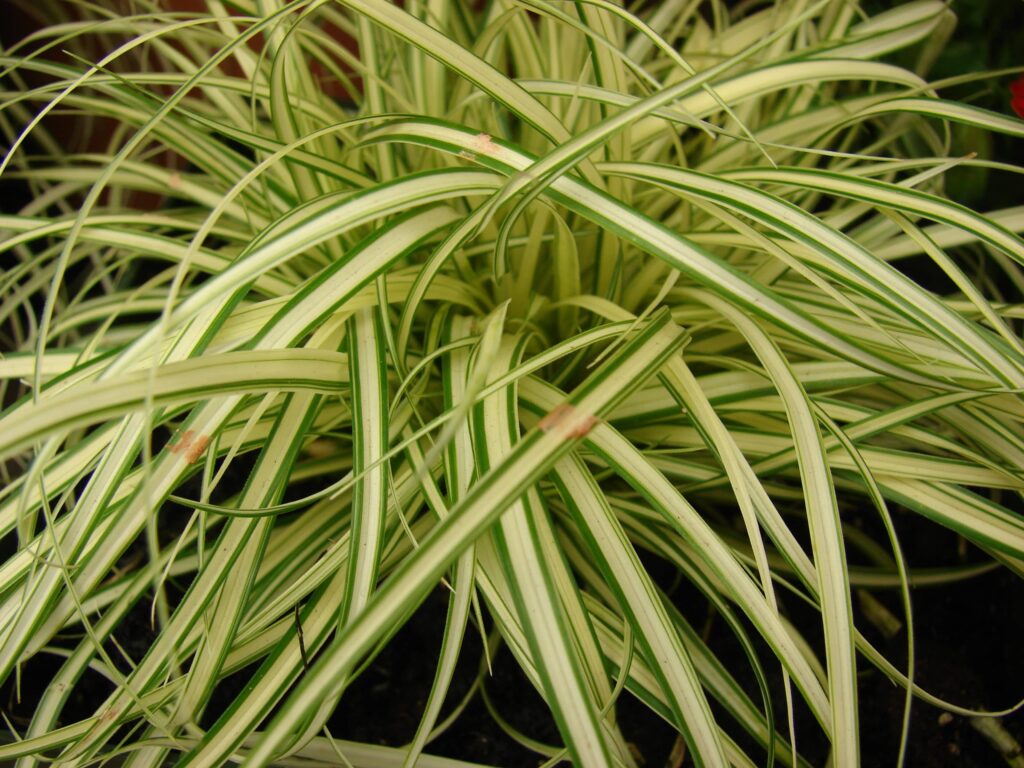
The go-to non-grass grassy-looking ground cover for wet shade.
- Height: 14-16 inches
- Range: Native to Asia
- Climate: Zones 5-9
- Functions: Ornamental fountaining foliage is often found in heavy shade, preventing erosion, deterring deer, and thriving in damp or wet conditions. Popular in food forests and pest-resistant gardens.
- Light requirements: Full or partial shade.
- Soil preferences: Moist, light to heavy soils. Suitable for heavy clay.
Plants may be available here (Evergold sedge grass).
Allegheny spurge (Pachysandra procumbens)
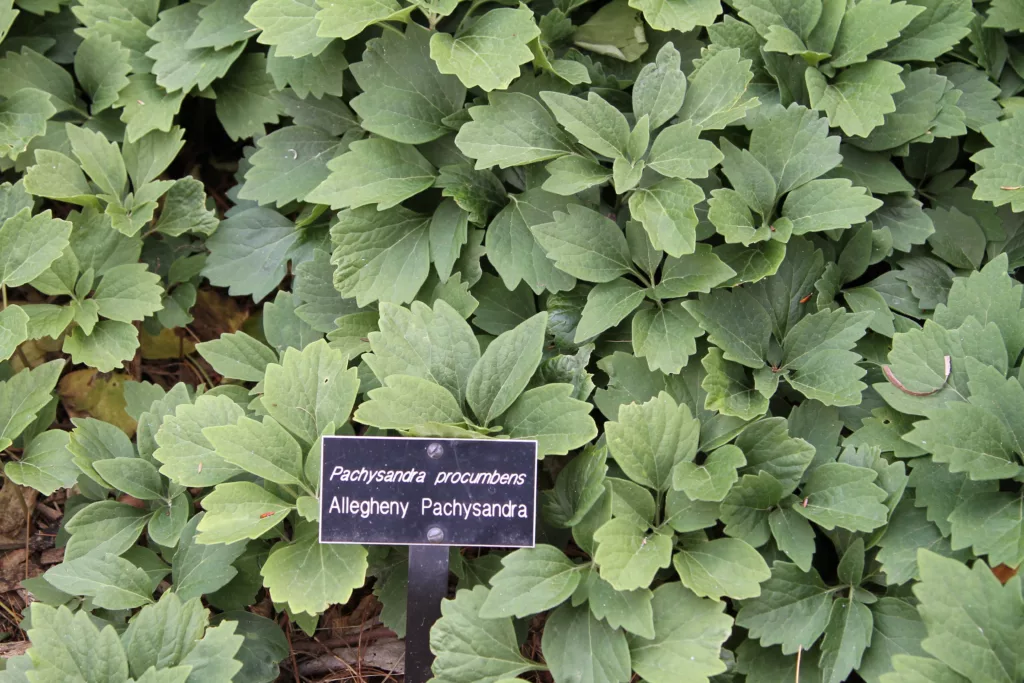
A shade-thriving semi-evergreen ground cover has A LOT to offer and is often included in polycultures.
- Height: 6-12 inches
- Range: Native to North America
- Climate: Zones 5-8
- Functions: Popular spring-fragrant semi-evergreen ground cover for native, rock, woodland, and food forest gardens. Dense carpeting formation, drought tolerant when established, adaptable to most soil types, and stays lush green with little effort.
- Light requirements: Full or partial shade
- Soil preferences: Moist soil. Acidic to neutral pH. Suitable for heavy clay.
A tougher variety to find from seed, but is often available in containers. Scotts Garden Center for Canadians or Rare Roots for Americans.
Related: 12 Shade-loving Ground Covers for Droughts & Low Effort
Yin Yang Huo (Epimedium sagittatum)

Best for wet or semi-dry deep shade. If you have heavy shade and either dry or wet soil, it can be difficult to find a suitable ground cover that will look good and thrive. This is a perfect candidate for a tough spot like that.
- Height: 10-18 inches
- Range: Native to Asia
- Climate: Zones 5-9
- Functions: Edible ground cover for rock or rabbit/deer-resistant gardens.
- Light requirements: Thrives in partial shade and tolerates full shade well.
- Soil preferences: Moist or dry soil. Suitable for dry shade or heavy clay.
A variety of flower and foliage coloring is offered from Nature Hills Nursery (referred to as barrenwort).
Great Yellow Woodsorrel (Oxalis grandis)

Also known as great yellow wood sorrel. Sorrel has a lemony flavor and often added to salads.
- Height: 8 inches
- Range: Native to North America
- Climate: Zones 5-7
- Functions: Edible addition to polycultures in native, woodland, or food forest gardens.
- Light requirements: Full to partial shade.
- Soil preferences: Moist-dry soil and suitable for heavy clay.
While tough to find this specific variety for sale online, you may find someone local who offers seeds or roots. Various other types of edible and shade-loving sorrel are offered here.
Chinese Wild Ginger (Asarum splendens)

Various semi-evergreen wild ginger ground covers are available for the choosing. Chinese wild ginger is hardy to zone 5. The others are hardier to zone 3 and zone 4. If you’re in zone 5-8 you can grow any or all of these wild gingers if you so choose!
- Height: 8 inches
- Range: Native to Asia
- Climate: Zones 5-9
- Functions: Edible roots and ornamental planting. Woodland gardens, pest resistance, and shaded edges.
- Light requirements: Full shade or partial shade.
- Soil preferences: Dry or moist soil with good drainage.
You’ll find wild ginger available by seed or root here.
Mottled Wild Ginger (Asarum shuttleworthii)
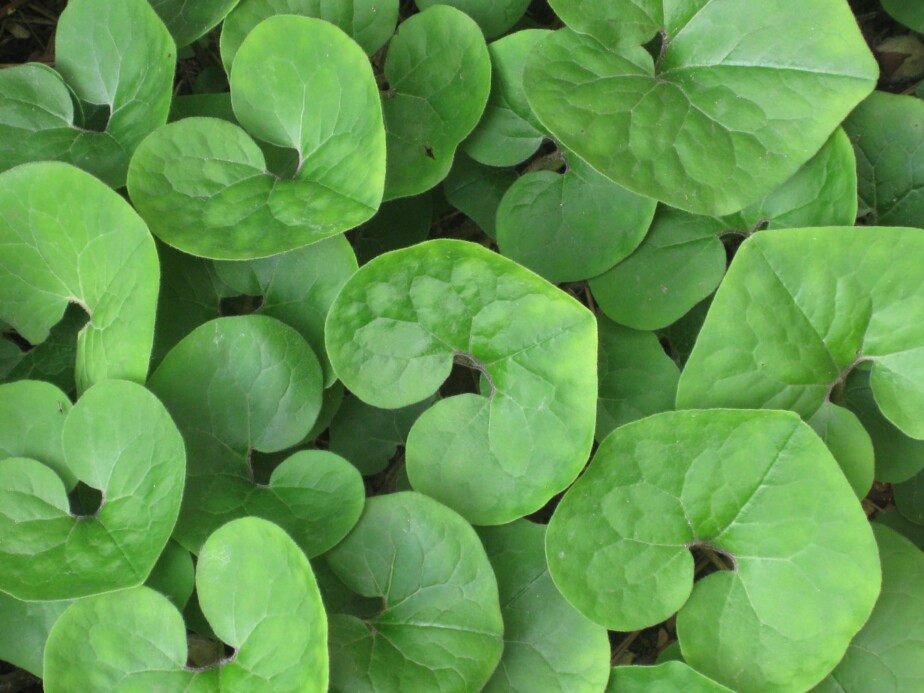
If you’re all about the ginger (and sticking to native species), this variety is native to North America and also thrive in the fullest of shades.
- Height: 4 inches
- Range: Native to North America
- Climate: Zones 5-9
- Functions: Fragrance, rock gardens, and edible polycultures.
- Light requirements: Full shade or partial shade.
- Soil preferences: Moist soil and good drainage. Suitable for heavy clay.
You’ll find wild ginger available by seed or root here.
Green and gold (Chrysogonum virginianum)

An easy-going and low-maintenance native ground cover with soft-petalled and nectar-filled flowers. This is a very popular ground cover as it fulfills ornamental value and wildlife preservation. Songbirds, bees, and butterflies love it!
- Height: 6-12 inches
- Range: Native to North America
- Climate: Zones 5-9
- Functions: Quick ground coverage. Pollinator or native gardens.
- Light requirements: Full, partial, or no shade.
- Soil preferences: Moist or dry soil with good drainage.
Also known as ‘golden star’ you’ll find it available here.
Chameleon Plant (Houttuynia cordata)

If you have a shaded area with too much moisture, wet soil, or even a little pool of water where nothing seems to grow, the chameleon plant may be your best choice—unless it is invasive in your area, please check first. However, it is primarily aggressive only in ‘perfect’ boggy conditions.
If the rest of your soil is dry and you have one spot with a lot of water or pooling, you may be able to control this edible plant easily. This plant requires these conditions under partial shade and it can also grow in full shade.
- Height: 10-14 inches
- Range: Native to Asia
- Climate: Zones 5-10
- Functions: Beauty. Borders. Massing. Edible. Fast ground coverage. June blooms. Unique flavoring.
- Light requirements: deep shade or partial shade.
- Soil preferences: Moist to wet soil or water.
Otherwise known as ‘fish-smelling herb’ (I know it sounded good, until now) and seeds can be found here.
Up Next: Best Zone 3 Ground Covers for Shaded Areas (With Pics)
Recent Posts
There’s no shortage of full-sun ground covers for zone 4 climates! Each plant in this list can withstand the frigid temperatures and also enjoy the hot sun in summer. Full sun means that a plant...
There's no shortage of full sun ground covers, not even in zone 3! Zone 3 climates offer hot but short-lived summers and very cold winters. So each plant in this list can withstand the frigid...
